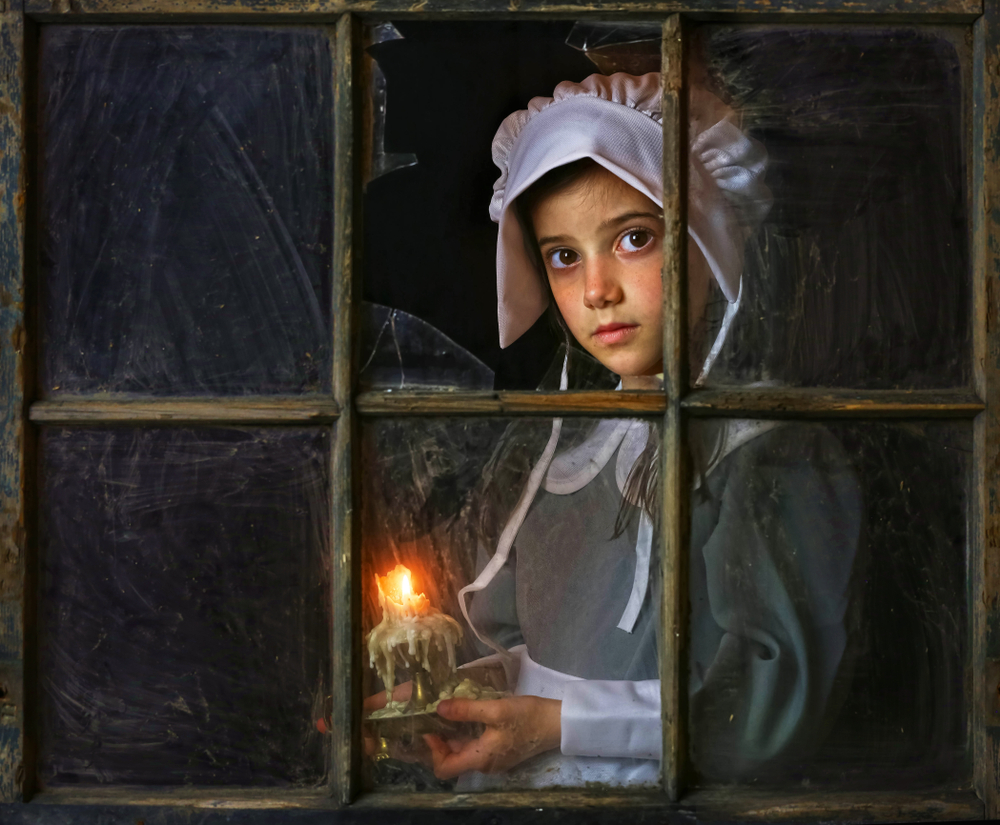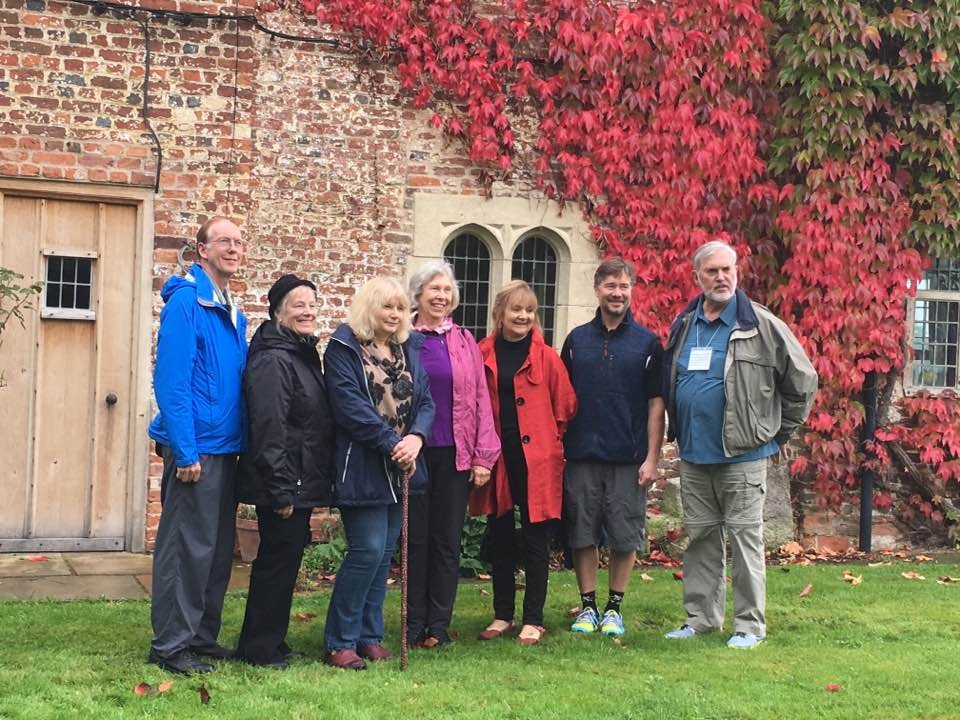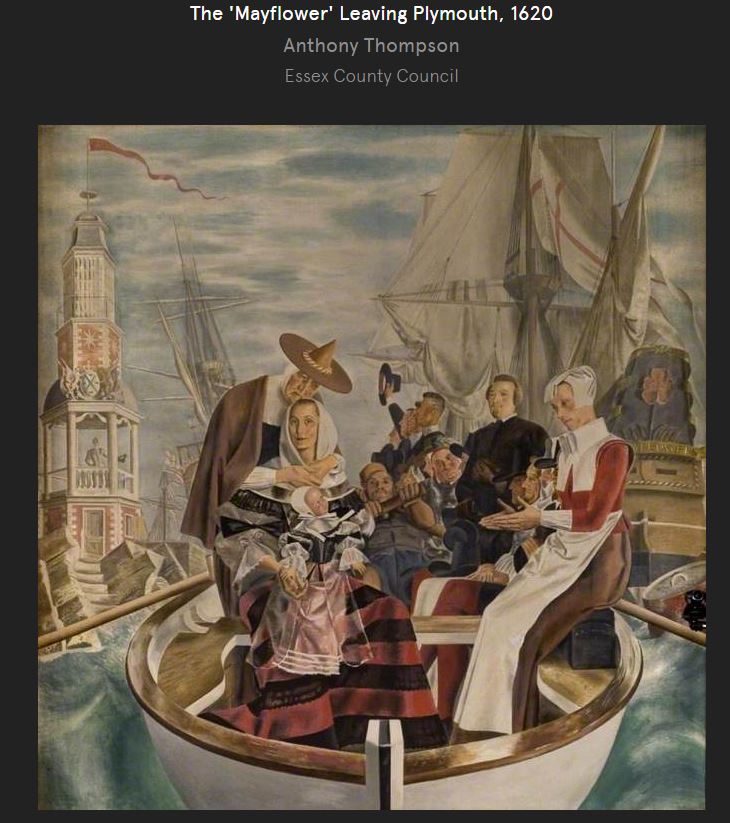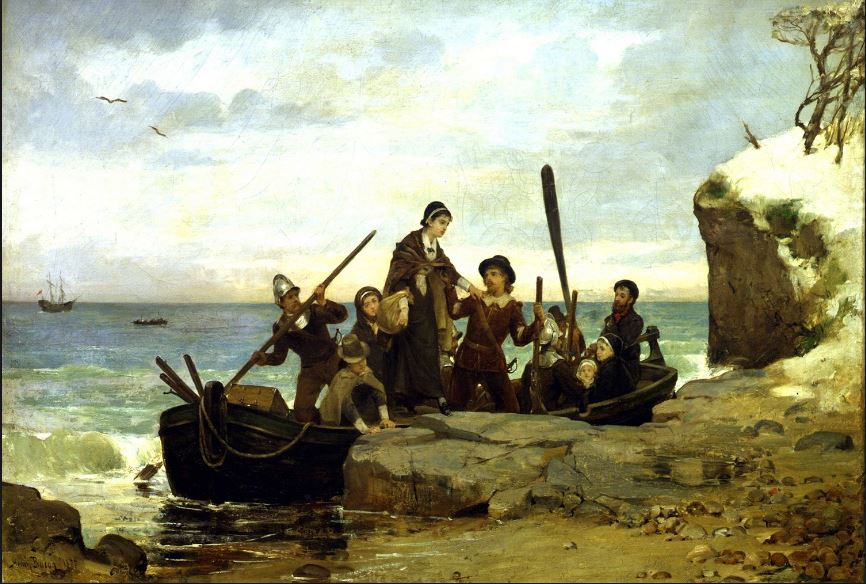

- Contact Us
- Search
-
Mayflower400 partner destinations:
Women of the Mayflower
There are precious few records of the women who boarded the Mayflower, but their strength and role in the voyage and settling in America cannot be underestimated.
Eighteen adult women boarded the Mayflower at Plymouth, with three of them at least six months pregnant.
They were Susanna White, Mary Allerton and Elizabeth Hopkins who braved the stormy Atlantic knowing that they would give birth either at sea in desperate conditions or in their hoped destination of America.
Women in 1620 had little rights and their history is patchy, given little thought was given to recording their endeavours.
When the ship arrived in Cape Cod, the men went to shore - spending two months trying to find a suitable place to settle before building storehouses and creating the beginnings of Plymouth. The women stayed on the Mayflower to care for the sick and the young - in damp, crowded and filthy conditions, which meant many would die before they were able to step foot on land.
Just five women would make it through that first, harsh winter.
Here, we take a closer look at some of the women and girls who boarded the Mayflower, and their origins in England.
You can explore more of the Mayflower Story here and explore all the passengers origins in our interactive guide.

Susanna White-Winslow
Susanna gave birth to Peregrine while the ship was anchored in Cape Cod in late November 1620 (she also travelled with a fiver-year-old son called Resolved as well). Peregrine would become known as the ‘first born child of New England’ and become a prominent farmer and military captain. Susanna’s husband William would sadly die weeks months later in February 1621.
Susanna, now with a newborn son and a five-year-old to care for, was the only widow who survived that perishing first winter in America and one of five women to do so - the others being Elizabeth Hopkins, Mary Brewster, Eleanor Billington and Katherine Carver - who sadly died in May 1621.
These four women, together with young daughters and male and female servants, would go on to cook the first iconic Thanksgiving feast.
She would marry again, to widower Edward Winslow, and have five children - their’s would be the first marriage in the new Plymouth Colony on May 12, 1621. Susanna would certainly have been one of the more prominent figures in the new settlement, married to Edward, who was a leader in the community.
She is buried in Winslow Cemetery in Marshfield, Massachusetts, where today there is a large stone memorial bearing her name along with her children and second husband.
In recent years new evidence has surfaced that links Susanna to Nottinghamshire, where it believed she lived at Scrooby Manor.
Evidence uncovered by local historian and expert in English Separatists, Sue Allan, indicates that Susanna resided at Scrooby Manor in North Nottinghamshire before making the epic journey to New England in 1620.
“The origin of Susanna Winslow has long been a mystery as, until now, we’ve been unable to identify her maiden name and birthplace,” said Sue Allan.
“Identifying the origins of the female pilgrims is a real challenge as there is generally so little information recorded about them – women had very few rights at that time, but they are so significant when painting the picture of the Pilgrim history.”

Historian Sue Allan (third from left) with American descendants of Susanna White outside Scrooby Manor
But a poignant letter penned by her second husband Edward Winslow in 1623 provided an important link between Susanna and the Jackson family, including leaseholder of Scrooby Manor, Richard Jackson.
Sue continued: The letter we uncovered was the missing link we needed to conclude that Richard Jackson was in fact Susanna’s father and prove her Nottinghamshire origins. This is really exciting – Susanna was a very important figure; not only was she aboard the Mayflower ship, she was also pregnant during the voyage and gave birth to the first child to be born once the Mayflower reached America.
“After her first husband William White died that first winter, Susanna underwent the first marriage in New England – to Edward Winslow who became three times Governor of the Plymouth Colony.”
Elizabeth Hopkins
Elizabeth gave birth while at sea, to a boy she aptly named Oceanus - who would tragically die aged two after the Pilgrims had settled into a life of hardship in their new surroundings.
She survived the first winter to cook the first Thanksgiving feast but little is known of her origins or what would become of her.
She married Stephen Hopkins on 19 February 1617/8 at St Mary Matfellon Church in Whitechapel, and had a daughter Damaris born somewhere in England around 1618. They were part of a group of Pilgrims known as the ‘Strangers’ who were not part of the congregation of Separatists living in Leiden, Holland.
The Strangers made up more than half the Mayflower passengers are were merchants, craftsmen, skilled workers and indentured servants, and three young orphans. All were common people, and about one-third of them were children - and they were crucial to the colony’s success.
They would have initially boarded the Mayflower in Rotherhithe, before they met up with the leaking Speedwell in Southampton. They would stop again in Dartmouth and Plymouth before setting off for America.
Priscilla Alden
Priscilla was not one of the 18 women recorded to have crossed the stormy Atlantic - she was just a child at the time, one that had a hard start to her new life.
Her father William Mullins died on February 21 while the ship was docked for four months. His wife and daughter (and Priscilla’s mother and brother) Alice and Joseph died in the first winter, meaning Priscilla started life in America as an orphan at the tender age of 18.
She was originally born in Dorking, Surrey, and went on to marry John Alden in what is thought to be the third marriage in the Plymouth colony. Priscilla was one of the surviving women, who became a family, and fought through the hardship to help the colony eventually thrive.
She is probably the best known from the poem The Courtship of Miles Standish by Henry Wadsworth Longfellow. According to Longfellow’s legend, John Alden spoke to Priscilla Mullins on behalf of Miles Standish, who was interested in the lovely young woman. But she asked, “Why don’t you speak for yourself, John?”
By 1627 they were living in a house on the hillside, across from the Governor’s house and near the fort. John Alden served in various offices in the government of the Colony. He was elected as assistant to the governor and Plymouth Court as early as 1631, and was regularly re-elected throughout the 1630s. Priscilla would become a leading figure in the colony.

Mary Allerton (nee Norris)
Mary Norris was possibly born in Welford, near Newbury, in 1592 and wed Isaac Allerton in November 1611.
Mary was around 30 years old when she travelled to North America with her husband, Isaac, and three children, Bartholomew, Remember, and Mary. She was an active member in the Leiden church, and was pregnant when left Leiden on the Speedwell for Southampton, before transferring to the Mayflower.
She and Isaac had already buried a child at St Peters, Leiden, on 5 February 1620, before she gave birth to a stillborn son in Plymouth Harbour later the same year.
Mary herself died during the first winter, on 25 February 1621, though her husband and three children all survived. Four years later, Allerton remarried Fear Brewster (daughter of William Brewster) and had two children, Sarah and Isaac.
After the death of his second wife, he moved to Marblehead and remarried Joanna Swinnerton in 1637. Allerton died in New Haven in 1659.
Mary Cushman (nee Allerton)
Born in Leiden, Holland, in 1616, Mary Allerton boarded the Mayflower at just four years old together with her parents, Isaac and Mary (nee Norris) Allerton.
In 1637, she married Thomas Cushman, who had arrived in Plymouth 16 years earlier on the Fortune with his father, Robert Cushman.
Thomas and Mary had eight children, of whom seven - Thomas, Mary, Sarah, Isaac, Elkanah, Fear, Eleazar, and Lydia - survived until they were adults. The children also married and provided their parents with at least 50 grandchildren.
Both Thomas and Mary lived to very old age, with Mary dying at the age of 83, and Thomas living until age 83. In fact, before her death on 28 November 1699, Mary was the last surviving Mayflower passenger.
Eleanor Billington
Eleanor Billington boarded the Mayflower in 1620 with her husband, John Billington, and their two sons, John and Francis.
She was one of only five adult women to survive the first winter, and one of only four who were still alive for the First Thanksgiving in the autumn of 1621.
However, the Billington family was not part of the Pilgrims separatist community, and had a reputation of being ill-behaved. Just six years after her husband was executed for murder - after he shot and killed John Newcomen, a recent settler - Eleanor herself was sentenced to the stocks and whipped, following a slander against John Doane.
She later remarried to Gregory Armstrong, between 14 and 21 September 1638, but had no additional children with him. Eleanor is said to have died in Plymouth in March 1643.

Mary Brewster
Not much is known about Mary, but it is believed she was born in around 1569, because in an affidavit filed in Leiden, Holland, in June 1609, she then stated she was 40 years old.
It is presumed Mary was from somewhere in the vicinity of Doncaster, Yorkshire, or Scrooby, Nottinghamshire, as she married William Brewster in that area about 1592.
Their first son, Jonathan, was born in Scrooby a year later, before a daughter, Patience, arrived in around 1600 or somewhat earlier.
About 1606, the church congregation began more formally meeting at the Scrooby Manor, where she and husband William resided.
With her husband’s involvement in establishing a separatist church with Richard Clyfton, using the Scrooby Manor for meetings - and with pressure mounting from the English authorities - Mary gave birth to another daughter, Fear, before the couple fled to Leiden with the other members of the congregation.
In Leiden, they buried an unnamed child - presumably one who had died in infancy - before Mary gave birth to two more sons, named Love and Wrestling respectively.
Mary sailed to Plymouth aboard the Mayflower in 1620 with her husband and her two youngest children.
She was one of only five reported adult women aboard who survived the first winter, and one of just four still alive for the so-called ‘First Thanksgiving’ in the autumn of 1621.
Brewster's son, Jonathan, joined the family in November 1621, arriving at Plymouth on the ship Fortune, before his daughters, Patience and Fear, arrived in July 1623 aboard the Anne. Sadly, both daughters later died in 1634, when smallpox and influenza ravaged the region.
Mary passed away in Plymouth in 1627, at about the age of 60. Her husband, William, never remarried and died 17 years later.
Dorothy Bradford (nee May)
Daughter of Henry and Katherine May, Dorothy was born in Wisbech, Cambridgeshire, about 1597.
New research by Sue Allan and Caleb Johnson has shown that Dorothy certainly moved to Amsterdam around 1608 with her non-conformist father, who was a leading church elder in the Henry Ainsworth church congregation in the city.
Five years later, 16-year-old Dorothy married William Bradford, then 23, before returning with her husband to take up residence in Leiden.
The couple had a child, John, who was probably born in 1617, though he was left behind when Dorothy and William sailed for North America - presumably with the intention of sending for him when Plymouth Colony was built and more suitable for a young child.
The Mayflower anchored off Provincetown Harbour on 11 November 1620, and the Pilgrims sent out several men to explore the region to seek out the best place to build their Colony.
Less than a month later, while her husband was ashore exploring, Dorothy accidentally drowned in the freezing waters of the Harbour after falling from the Mayflower.
In June 1869, a fictional story was published in Harper's Weekly, in which Dorothy's fall from the Mayflower was portrayed as a depression-induced suicide, involving an affair with Master Christopher Jones.
Although this story had no historical proof, it has nevertheless made it into some popular accounts of the Pilgrims and gets regularly debated in television documentaries about the Mayflower.

Humility Cooper
Humility was the youngest passenger aboard the Mayflower, being only one year old when she journeyed across the Atlantic with her aunt and uncle, Edward and Ann Tilley (nee Cooper).
Her father, Robert Cooper - who was originally from Henlow, Bedfordshire - was living in Leiden, Holland, at the time and is believed to have passed Humility to the Tilleys.
Both Edward and Ann died in the winter of 1620/1621, after which Humility was sent back to either England or Holland.
Records show that in 1638, she was baptised in London, but no other record of her or any family has been found - outside of the fact that William Bradford, writing in 1651, indicated she had died.
Desire Minter
Records show the Minter family were present in Leiden in 1613. They came from Norwich, so it is likely that Desire was born there or nearby.
Her father, William, died in 1617 or early 1618 and her mother, Sarah remarried, with John Carver acting as a witness.
Desire possibly became a maid servant to Thomas Brewer as in 1622, he signed a document stating he owed money for 'raising the daughter of William and Sarah Minter'.
As Brewer was arrested for printing pamphlets, he may have moved Desire to the care of Carver, who then took her with him on the Mayflower.
After Carver’s death in 1621, Desire was one of the people (Humility Cooper was another) who returned to England.
According to William Bradford, 'Desire Minter returned to her friend and proved not very well and died in England'. Some sources say she died sometime before 1651.
- To explore more of the passengers take a look at our interactive guide and follow the Mayflower trail of destinations which take in their origins.
- For more information about Sue Allan, historian and tour guide visit www.mayflowermaid.com
Sign up for the latest Mayflower 400 news
You'll be the first to hear the latest Mayflower news, events, and more.
Log In
Register
Mayflower 400 Proudly Supported by our National Sponsors and Funding Partners






